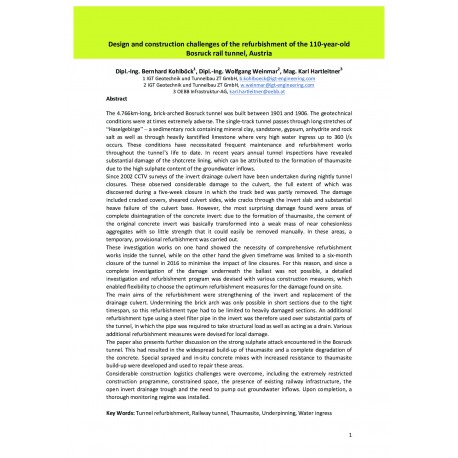Cart
0
0
No document
0,00 €
Total
Document successfully added to your shopping cart
Quantity
Total
There are 0 items in your cart.
There is 1 item in your cart.
Total documents
Total shipping
To be determined
Total
Search & filter
Search for a publication
Search & filter
Design and construction challenges of the refurbishment of the 110-year-old Bosruck rail tunnel, Austria
1749_design_and_construction_cha
W. Weinmar / B. Kohlböck / K. Hartleitner
The 4.766km-long, brick-arched Bosruck tunnel was built between 1901 and 1906. The geotechnical conditions were at times extremely adverse. The single-track tunnel passes through long stretches of “Haselgebirge” – a sedimentary rock containing mineral clay, sandstone, gypsum, anhydrite and rock salt as well as through heavily karstified limestone where very high water ingress up to 360 l/s occurs. These conditions have necessitated frequent maintenance and refurbishment works throughout the tunnel’s life to date. In recent years annual tunnel inspections have revealed substantial damage of the shotcrete lining, which can be attributed to the formation of thaumasite due to the high sulphate content of the groundwater inflows. Since 2002 CCTV surveys of the invert drainage culvert have been undertaken during nightly tunnel closures. These observed considerable damage to the culvert, the full extent of which was discovered during a five-week closure in which the track bed was partly removed. The damage included cracked covers, sheared culvert sides, wide cracks through the invert slab and substantial heave failure of the culvert base. However, the most surprising damage found were areas of complete disintegration of the concrete invert: due to the formation of thaumasite, the cement of the original concrete invert was basically transformed into a weak mass of near cohesionless aggregates with so little strength that it could easily be removed manually. In these areas, a temporary, provisional refurbishment was carried out. These investigation works on one hand showed the necessity of comprehensive refurbishment works inside the tunnel, while on the other hand the given timeframe was limited to a six-month closure of the tunnel in 2016 to minimise the impact of line closures. For this reason, and since a complete investigation of the damage underneath the ballast was not possible, a detailed investigation and refurbishment program was devised with various construction measures, which enabled flexibility to choose the optimum refurbishment measures for the damage found on site. The main aims of the refurbishment were strengthening of the invert and replacement of the drainage culvert. Undermining the brick arch was only possible in short sections due to the tight timespan, so this refurbishment type had to be limited to heavily damaged sections. An additional refurbishment type using a steel filter pipe in the invert was therefore used over substantial parts of the tunnel, in which the pipe was required to take structural load as well as acting as a drain. Various additional refurbishment measures were devised for local damage. The paper also presents further discussion on the strong sulphate attack encountered in the Bosruck tunnel.




